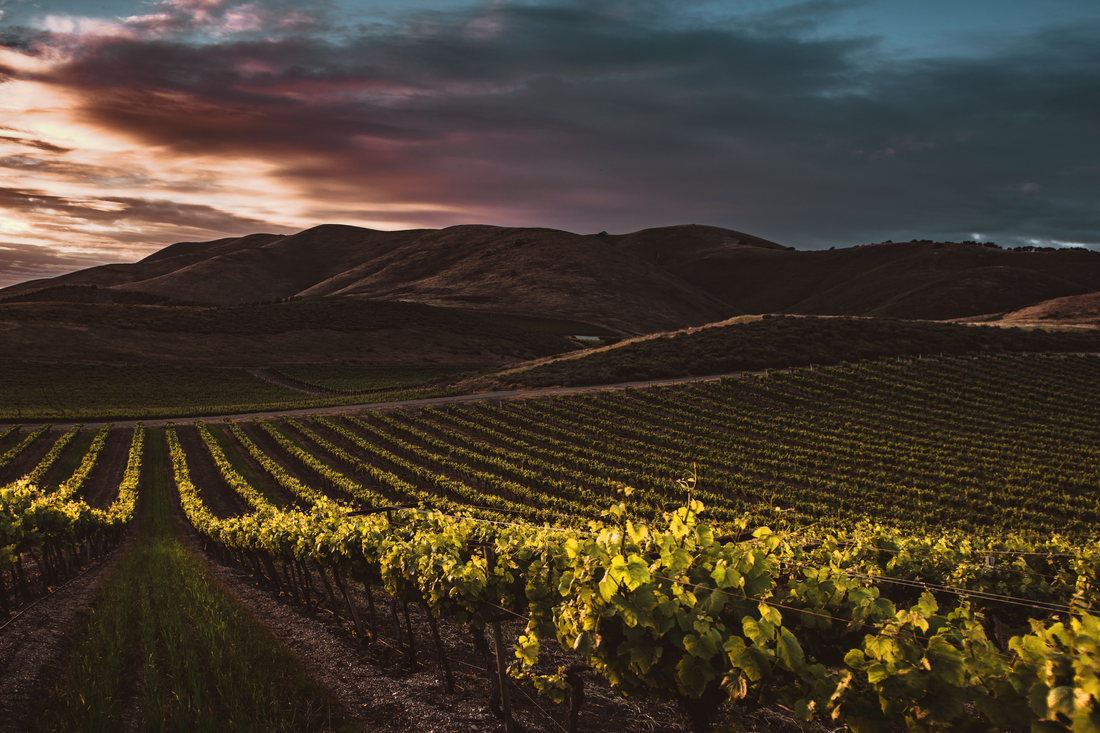Management of soils and plant covers in Agro-Synergic production:
the why and the how
Soil health enthusiasts have learned the value of tangled biomass growing above ground in a diverse cover mix; a similar diversity benefits the soil root systems and all the microbiota that surrounds it. Thus, we seek to obtain a root system that explores all corners of the soil with large, deep vertical roots and small, shallow, horizontal roots. Storing carbon in the soil is critical to improving soil health and the carbon released through the soil cycle.
roots is more stable than that of the aerial parts of the plant.
The aim of this grass cover is, in particular, to obtain a vine that is self-sufficient in nitrogen and naturally better able to draw macro and microelements from the soil. The organic matter accumulated at depth produces a stable humus necessary for soil texturing and a more labile humus which is metabolized by the soil microbiota for its own nutritional needs, but in return, the vine benefits from the by-products of their metabolism. Nitrogen is therefore no longer supplied to the plant solely by mineralization and the depletion of the stock of organic matter in the soil, but also by the fixation of inexhaustible atmospheric nitrogen by certain soil micro-organisms. These ultimately become a source of nutrients for our plant. The cycle is complete. The colonization of vine roots by ecto or especially endophytic fungi is an established fact. Thanks to an extremely dense and branched microscopic tissue, these mycorrhizae
make it possible to improve the connection of the vine's root system with its soil. Its nutrition is facilitated (the assimilation of phosphorus for example is greatly facilitated by this symbiosis which explains the absence of need for exogenous fertilization), its resistance to parasites and its water supply during periods of improved restriction .
Biological activity and rhizospheric microbiota
In return, the vine devotes a significant part of its photosynthesis to providing the metabolized carbon that these microorganisms are incapable of producing. A vine that is too well nourished, artificially or naturally, will not need these symbionts and will therefore not invite them! Under these conditions, it will lose the benefit of their positive interactions when environmental conditions deteriorate. We must therefore always keep in mind that a certain
“austerity” in the nutrition of the vine is in fact necessary for its balance and its long-term resilience in the event of a sudden and negative modification of the ecosystem. We use biometric tools to measure the quantity and diversity of the complex microbiota of our soils using innovative molecular biology techniques. We can thus follow the evolution of different types of bacteria, nematodes, free fungi and mycorrhizae in the surface layer and the rhizosphere to control their evolution and the quality of their interactions. The rate of mycorrhization of vine roots remains
nevertheless difficult to quantify easily. We seek to obtain a microbiota dominated by humigenic fungi and fewer bacteria
mineralizing with a high proportion of endomycorrhizas and a ratio between
Balanced phytophagous/omnivorous/carnivorous nematodes. Measurement of activities
mineralizer of the Carbon and Nitrogen cycle allows us to quantify
the biological activity of the soil and its nutrient supply.
Unlike ambient communication, it is not necessary to plant trees among the vines so that they can be mycorrhized...If this were the case, then this would reveal a worrying problem at the level of the soil concerned...The trees are Are they facilitators of mycorrhization for the vine? Nothing has yet proven this because their mycorrhizae are quite different from those of the vine. The roots of trees are indeed home to many fungi, but some are also pathogenic for vines (Armilaria sp. root rot). Likewise, if the subject of the deep roots of the vine is legendary, it is above all a legend... We often cite roots several meters or tens of meters deep in the ground, but these are mainly fables... Most of the effective rooting of the vine will be, depending on the soil, between 50 cm and 2 m; it is in these horizons that the vine can feed effectively. Beyond that, we can sometimes find exploratory roots of several meters, even ten meters, especially horizontal, and sometimes plunging into
particular soils, such as deeply fractured rocky soils (limestone, shale), but not really in “classic” soils where the availability of oxygen becomes rarefied too quickly at depth to authorize their installation and operation… In the same way, the need of deep soil to allow the vine to express the complexity of a terroir is another fable: great wines can be produced on deep or very superficial soils provided that their texture and structure allow the root system to operate in a balanced manner. A superficial soil, if the parent rock is
sufficiently porous and allows a sufficiently available water reserve and pantry, can perfectly produce exceptional wines as on the Saint-Emilion plateau where the Gallo-Romans excavated channels in the limestone rock at Astéries (star cluster of the sea from the Tertiary era) over a few tens of centimeters and filling them with palus soil to be able to plant the vines. On these very superficial soils, the rooting of
the vine is limited and yet the vine never suffers from excessive water stress, particularly in summer when the water contained in the porous limestone (which is however not colonized by the roots) actively participates in the water supply to the vine through capillary rises like a sponge.
In our Agro-synergic organization, we do not seek to carry out systematic sowing, using exogenous seeds, intended to be buried each year (green manure), because the level of organic matter in the soil is not sustainably and positively impacted with this technique and the nitrogen supply possibly too abrupt and limited at the end of spring. Permanent grass laid down, or mowed at worst, is preferred. The vine, especially if it must produce great red wines and contrary to the needs for producing white or rosé wines, does not cope well with too much nitrogen nutrition, but it needs regular availability to key moments in its development and you should not hesitate to provide it if a deficit is detected. To do this, if necessary, we have at our disposal animal composts (chicken droppings, feather compost, fish guano) of organic origin to fulfill this function from spring, in localized supply under the row in order to reserve them preferably in the vineyard. In addition, knowing that there are profound differences between the root systems of specific species and that each type of soil must have a plant cover intrinsically corresponding to it, we prefer to manage the plant cover of our vineyards with predominantly natural grass cover. Endemic species quickly recolonize the
environment and develop concomitantly with the species initially installed, succeeding one another over the seasons because we let them flower and transplant naturally. We thus obtain increased biodiversity and, above all, perfectly well adapted to each ecosystem. A survey of above-ground as well as underground biodiversity and of the different bio-indicator species characteristic of the plots of each terroir and microclimate must be carried out annually to quantitatively and qualitatively monitor biodiversity.
cultivated ecosystems. It is also possible by carrying out sowing on site, non-destructive of the old one, to supplement the flora if particular needs are felt in terms of soil structuring (sowing of rye, fodder radishes, etc.) or supply of nitrogen (sowing clover, fava bean, Narbonne vetch, etc.) for example. Approximately every ten years, this natural permanent grass cover must often be destroyed because species that compete with the vines, such as the famous quackgrass Elymus repens, tend to excessively colonize the environment and become competitive.
The plant cover develops to a height of 55 to 80 cm depending on the species until the end of spring. We are waiting for the plants to flower and their stems to lignify; the cover is then mown or laid down to create a natural plant mulch which will then slowly decompose on the ground without being buried. Repeating this simple practice over the years can considerably enrich the level of total organic matter and
to sustainably boost the biological activity of the soil and to regenerate endemic species through natural sowing. Depending on the rainfall pattern of the year, the plant cover can be mowed on site once or twice at most; more generally we let the cover balance naturally.
It is desirable to practice bedding or mowing around seeding because it is at this time that the reserves are accumulated as much as possible in the aerial parts, that the lignification of the tissues is well developed and that a self- sowing can be carried out. Another justification is to simulate grazing of the plant cover. In fact, a cover left to grow permanently will not accumulate the same quantity or the same quality of reserve in the tissues. When a canopy plant is cut down, it has very little ability left to create the elements necessary for the formation of new plant cells through photosynthesis. It is therefore essential that the grass, at the time of cutting, has sufficient reserves in its roots or the bases of its stems which will allow the formation of a certain green part, which, through photosynthesis, will then allow the normal growth of the plant. . Any new growth, that is to say any regrowth of our grass plants, always occurs at the expense of organic substances previously developed (before cutting). If we cut or lay down the cover before the roots and the uncut part have stored sufficient reserves, regrowth will be difficult and may not even happen at all.

